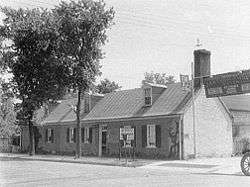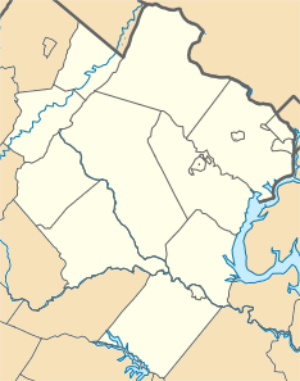James Monroe Law Office
|
Monroe Law Office | |
 | |
   | |
| Location | 908 Charles Street, Fredericksburg, Virginia |
|---|---|
| Coordinates | 38°18′9″N 77°27′42″W / 38.30250°N 77.46167°WCoordinates: 38°18′9″N 77°27′42″W / 38.30250°N 77.46167°W |
| Built | 1786 |
| Part of | Fredericksburg Historic District (#71001053) |
| NRHP reference # | 66000917 |
| VLR # | 111-0066 |
| Significant dates | |
| Added to NRHP | November 13, 1966[1] |
| Designated NHL | November 13, 1966[2] |
| Designated CP | September 22, 1971 |
| Designated VLR | September 9, 1969[3] |
The James Monroe Museum and Memorial Library is a historic museum at 908 Charles Street in Fredericksburg, Virginia. It is located on the site of the James Monroe Law Office, used by future United States President James Monroe from 1786 to 1789. It was declared a National Historic Landmark in 1966.[2][4] It is now owned by the Commonwealth of Virginia and operated by the University of Mary Washington. The museum features original objects and memorabilia related to James Monroe, and includes several items relating to other members of his family, including dresses worn by First Lady Elizabeth Monroe.
Description and history
The Monroe Museum is located in central Fredericksburg, on the west side of Charlest Street, between William and George Streets. It is housed in a two-part building that is roughly L-shaped. The older portion is a long 1-1/2 story brick structure, with a gabled roof, built in 1758. To this is attached a larger 1-1/2 story square brick building dating to 1964, when the museum and library were organized. The addition houses Monroe memorabilia, and a small library containing volumes similar to those that might have been in Monroe's library. The museum also houses a collection of furnishings and other artifacts belonging to the Monroes, although most date to the 19th century.[4]
The outside includes a memorial garden to James Monroe, which features a bust of him sculpted by Margaret French Cresson, daughter of Daniel Chester French.
This building housed the law office of the future United States President James Monroe from 1786 to 1789. Monroe had prior to this time served in the Virginia House of Delegates, and in the Congress of the Confederation, from which he resigned in 1786, dissatisfied with the politics of that body. In 1788 he was involved in the delegate to the Virginia convention on the adoption of the United States Constitution, which he opposed.[4]
Monroes's law office was acquired in 1928 by Laurence Hoes, a Monroe family descendant who established the Monroe Foundation to manage the property. He accumulated a variety of artifacts related to his illustrious ancestor, restored the property, and opened it as a museum. In 1964 the addition was built, and the Monroe Foundation gave the property to the state. It is now managed by a board consisting of members of the Monroe Foundation and the regents of the University of Mary Washington.
See also
References
- ↑ National Park Service (2007-01-23). "National Register Information System". National Register of Historic Places. National Park Service.
- 1 2 "James Monroe Law Office". National Historic Landmark summary listing. National Park Service. Archived from the original on 2009-01-09. Retrieved 2008-04-16.
- ↑ "Virginia Landmarks Register". Virginia Department of Historic Resources. Retrieved 19 March 2013.
- 1 2 3 Stephen Lissandrello (February 25, 1975). "National Register of Historic Places Inventory-Nomination: James Monroe Law Office" (pdf). National Park Service. and Accompanying six photos, from 1965 and 1966 (32 KB)
External links
![]()
- Monroe Foundation history
- James Monroe Law Office Museum and Memorial Library - University of Mary Washington website
- James Monroe Law Office Museum and Memorial Library - Park Service website
- Photos
- "Life Portrait of James Monroe", from C-SPAN's American Presidents: Life Portraits, broadcast from the James Monroe Memorial Museum, April 12, 1999

